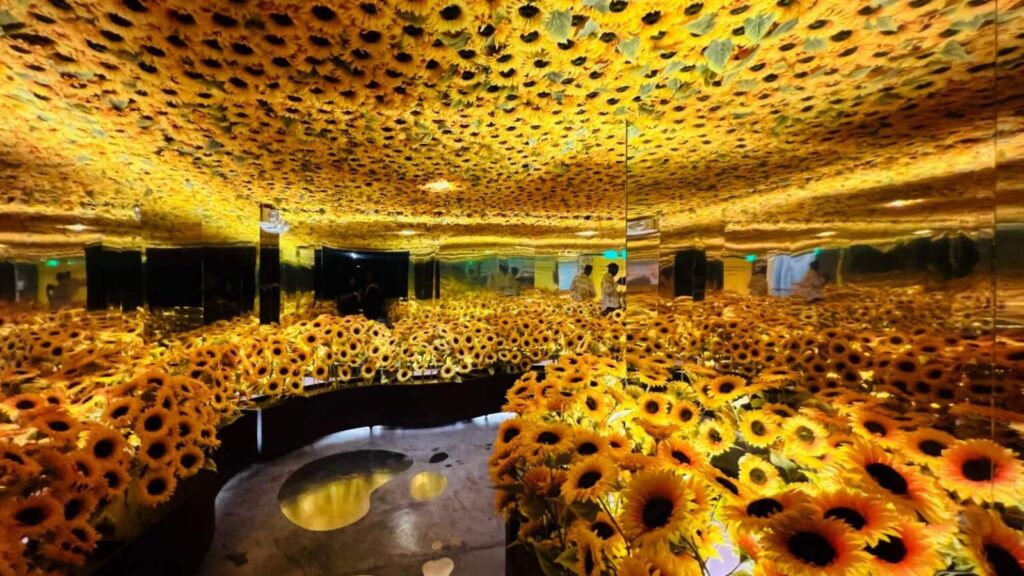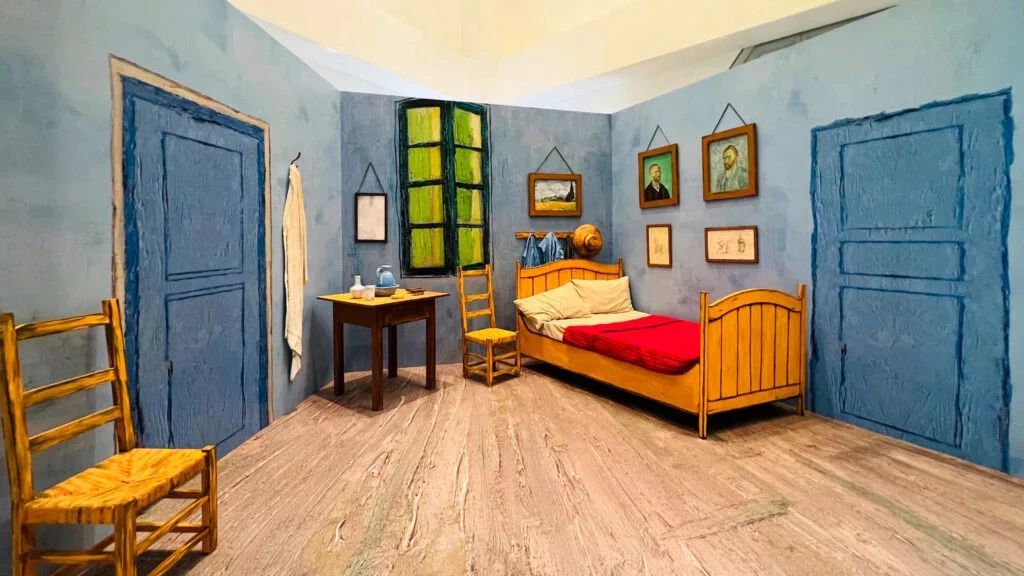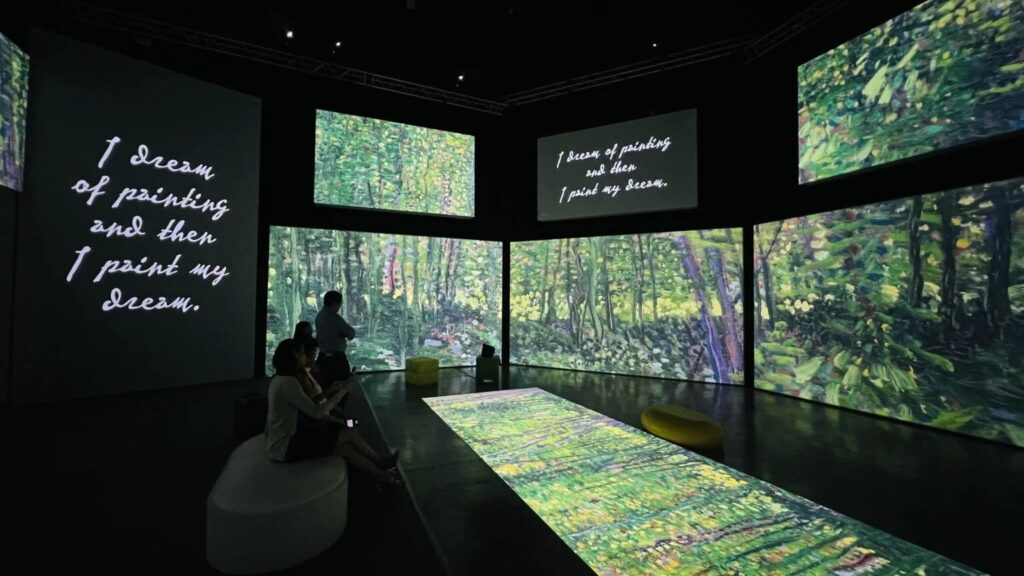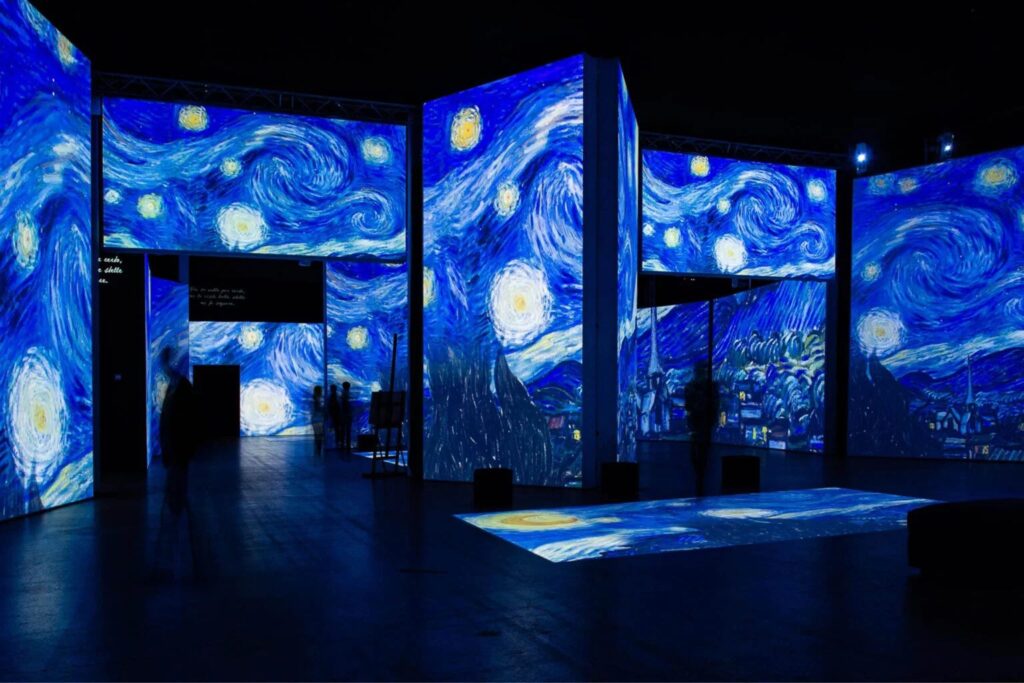A visual delight of hues awaits as viewers enter the BGC Arts Center in Taguig City to immerse themselves in the multisensory experience that is “Van Gogh Alive”, ongoing until Dec. 28.
Over 3,000 vast images of color surround the audience, set to an evocative classical score, as the sights around transport visitors into the world of Vincent Van Gogh.
Explore the work and life experiences of this prolific Dutch artist from 1880 to 1890. Interpret his thoughts, feelings and state of mind during his time in Arles, Saint Rémy and Auvers-sur-Oise, where he created many of his timeless masterpieces. Photographs and videos have also been augmented with Van Gogh’s works to demonstrate his sources of inspiration.
Van Gogh images at enormous scale create a thrilling display that fills giant screens, walls, columns, ceilings and even the floor – immersing you entirely in the vibrant colors and vivid features that constitute the artist’s unique style. A key part of it all is the music, so perfectly matched to the artworks that are unfurling before your eyes.

Light animations are added to the pieces – cigarette smolders, a steam train puffs through a landscape, the famous “Starry Night” twinkles, and reflections ripple. Crystal-clear representations of Van Gogh’s paintings to cropped details of his works and animated brushstrokes of the great master such as the swirling sky over a cornfield brought to digital life are beamed before viewers. At other times, elements move across the drawings such as birds or sheets of rain – plucked as details and then re-imagined. Fragments of Van Gogh’s letters, photographs of the places where he painted, and quotes by the artist are also projected, and add context without overwhelming.
“The only time I feel alive is when I am painting,” Van Gogh said. Visit this exhibition, and you will see exactly what he meant. Even better, it will make you feel gloriously alive too. Be prepared for the almost overwhelming emotional oomph it delivers: it is not just profoundly beautiful, it is also profoundly moving.
Interactive exhibit
Created and produced by Grande Experiences and presented by the Bonifacio Art Foundation, Inc. with Del Monte Philippines, “Van Gogh Alive” has inspired over nine million people across 100+ cities around the world.
This is no ordinary art exhibition. Traditions of tiptoeing through silent galleries and viewing paintings from afar in quiet contemplation are forgotten as visitors find themselves interacting with art in ways they never imagined. From start to finish, visitors are surrounded by a lively symphony of light, color, sound and aroma that has been called an “unforgettable” multisensory experience. Van Gogh’s oeuvres come to life, giving visitors the sensation of walking right into his paintings, a feeling that is simultaneously enchanting, entertaining and educational.

Get to know Van Gogh and his artworks at the Introduction Hall. This immersive experience treats his work with respect, sharing info panels about his different styles, famous paintings and failing mental health, projecting a huge selection of his masterpieces, in a sympathetic chronological order, along with striking extracts from his own diary, giving insight into the mind of this creative and the angst and pain he confronted.
The projections also include images of Paris from the 1890s – maps, works that influenced Van Gogh’s paintings and a few contemporaries.
Be part of his story through the state-of-the-art SENSORY4 gallery. There’s a subtle scent pumped into the space but it’s a pleasant enough olfactory concoction, like a waft of earthy notes of vetiver and sandalwood. The info panel suggests the scents of rural summer France.
Draw Van Gogh’s famous artworks at the Art Studio, and take home your very own masterpiece. There are easels and blank canvases for visitors to follow a video tutorial on how to draw Van Gogh’s “The Starry Night”. This is a nice element as viewers gain perception of just how skilled Van Gogh was at his craft.
The Sunflower Room is for Instagrammers – a mirrored room with hundreds of bright yellow sunflowers, a perfect background for selfies.
Capture creative photos at Vincent’s Bedroom. Walk in a life-size model of Van Gogh’s bedroom where you can have your picture taken sitting on the chair or bed.

The interactive show is a stylish, light concoction, and when you get a puff of sandalwood, a tart phrase from his letters and his huge hollow tortured face looking back at you from walls, it is engaging and thoughtful.
“‘Van Gogh Alive’ is a fascinating, cohesive story about one of the greatest known artists in history,” said Maria Isabel Garcia, managing director and curator of the Bonifacio Art Foundation, Inc. “It touches you on so many levels whoever you are. It is faithful to its promise to immerse you into the artist’s work, with glimpses into an inner life that led to his captivating masterpieces. ‘Van Gogh Alive’ will hold you long beyond your visit.”
Van Gogh’s life
On March 30, 1853, Van Gogh was born in Zundert, a small town in the Netherlands. Son of Theodorus Van Gogh, a Protestant pastor, and Anna Carbentus, an amateur artist who enjoyed making drawings of plants and flowers and keen watercolorist, he became increasingly aware of the difference between his middle-class wealth and poverty at an early age.
The artist left school at 16 and began work at Goupil & Cie, an art dealership that his uncle partly owned. Here he organized exhibitions and sold originals and reprints of artworks. The earliest surviving letter of Van Gogh originated from around this time.
In 1876, he was terminated from Goupil & Cie, and spent years seeking his direction, trying various jobs from schoolmaster to lay preacher.
Around 1881, he began to take drawing and painting lessons but fell out with his parents when his unrequited love for his cousin caused problems between them.
Van Gogh met Sien Hoornik, a former prostitute, in early 1882. His friends and family were shocked at his choice of moving in with a pregnant Sien and her five-year-old daughter. This relationship didn’t last as Van Gogh called it off the following year, and he moved back in with his parents.
Sadly, his father died in 1885, and Van Gogh moved into his studio, where he started work on his painting “The Potato Eaters”.
In 1886, Van Gogh arrived in Paris, where his brother Theo was living and managing the Goupil art dealers. He introduced Van Gogh to the brilliant work of modern artists like Claude Monet, who influenced his craft.
He began to long for the countryside and moved to Arles, a small town on the River Rhône, in 1888. During this time, he produced some of his most famous artworks, despite falling ill and cutting off his ear.



In a letter, he told Theo that he had an idea for a group of artists to live together, whose works Theo could sell. Unfortunately, Van Gogh could only convince Paul Gauguin to move in with him, but their relationship became tumultuous, leading Van Gogh to cut off his ear.
Van Gogh ended up in a hospital in Arles due to signs of “madness” but was discharged not long after. However, his mental health continued to decline, and he voluntarily admitted himself to Saint-Paul-de-Mausole psychiatric hospital in Saint Rémy.
During his year in the hospital, he managed to paint 150 pieces, including “Almond Blossom”, which he made for Theo and his wife, Johanna Bonger, on the birth of their son, who they named after Van Gogh.
Van Gogh’s artistry was starting to get noticed, and six of his paintings were shown in Brussels in early 1890. Not long after, he left the hospital and headed to Auvers-sur-Oise, an artists’ village near Paris.
After visiting Theo and Jo in 1890, Van Gogh became very concerned about his financial stability, which became too much to bear and culminated in his suicide on July 27, 1890.
He left behind over 850 paintings and nearly 1,300 works on paper, some of which were displayed in a memorial exhibition held by his brother.
Sadly, only six months later, Theo died of the effects of syphilis and Van Gogh’s paintings became the property of Theo’s widow, Jo. She began to raise awareness of Van Gogh’s incredible talent by lending his works to museums worldwide.
When Jo died in 1925, her son Vincent Willem loaned his uncle’s paintings to the Stedelijk Museum in Amsterdam, where his fame grew. Eleven years later, the artworks were moved to its own building, and Queen Juliana opened the Van Gogh Museum on June 2, 1973.
What many didn’t know about Van Gogh
Here are four things about Van Gogh many never knew and hope you uncover other interesting nuggets about the artist at the exhibition.
Pastor-turned-artist
Did you know Van Gogh wanted to make his father proud by following in his dad’s footsteps and training to be a pastor? The art world benefited when he aborted the idea and focused on becoming a painter. By all counts, Van Gogh was a late bloomer in art creation, but he was prolific once he started. Van Gogh did not pick up the paintbrush officially until he was 30 but lost no time making up for it. Most of his famous paintings were completed in the final two years of his life. Fancy that!
He created over 2,100 artworks in his lifetime
Thanks to his brother Theo who struck a deal with the hospital staff, so he could continue to paint during his one-year stay at the Saint Rémy asylum. This was when “The Starry Night” was produced. The asylum, tucked in the beautiful surroundings of Provence, where nature, art and music were believed to soothe the soul and mind, did wonders for Van Gogh’s prolific artistic period. He managed to produce the bulk of his work here.

He was on the verge of stardom before his early demise at 37
Painting the artist as a distressed soul who cut off his ear probably made for a romanticized image of him. Contrary to popular belief that Van Gogh died without finding fame, Van Gogh was well aware of his artistic talents during his lifetime. Besides being on the radar of an important art critic, he was already recognized for his talent by his creative peers such as Toulouse Lautrec, Cezanne, Renoir and Gauguin. Not just that, his artworks were also showcased at an exhibition in Brussels and a major show in Paris which the President of France graced. He also managed to secure 400 francs by selling “The Red Vineyard”, a tidy sum then. Equally sad and baffling, this happened just two months before he shot himself in the chest with a revolver.
His signature art style evolved from Japonisme
What do you think is the inspiration for the wild swirls of the night sky in “The Starry Night”? Would you have associated the Japanese Hokusai waves as the inspiration for his most famous painting? Like some of his artist peers, Van Gogh was not immune to the rise of Japonisme (a French term coined in the late 19th century to describe the craze for Japanese art and design in the West) that rose in late 1800s Europe.
“Van Gogh Alive” pays homage to Asian cultural influences which evolved into the artist’s signature style. Who would have thought that the Dutch artist borrowed inspiration from Japanese art?
Mesmerizing entertainment
“Van Gogh Alive” doesn’t just take you inside the paintings, it also takes you inside the mind of a genius, but a tormented genius. Along the way you will see works from across his career, from the portraits (self and otherwise) to the sunflowers and starry skies. All of it is marvelous, all of it displayed as you will never have seen it before. This exhibition advertises itself as immersive, and it genuinely is. In one hall you are surrounded by the master’s works on multiple canvases. Sometimes a single work is replicated on all the screens around you; mostly different ones. Always it is mesmerizing.
Adding to the richness of it all are things Van Gogh said: “I am always doing what I cannot do yet in order to learn how to do it” are words that will stay with you, perhaps the definition of the true artist. “I am seeking, I am striving, I am in it with all my heart” – words which define the passion you sense behind the paintings. But maybe most magical of all are the words “Be clearly aware of the stars and infinity on high. Then life seems almost enchanted after all.” Stand in this exhibition not just staring at his work, but actually, meaningfully within it, and you will feel that enchantment too.
While the hard-nosed critic might be dismissive of this blockbuster for its “cheesy” popularity and big splash spectacle, the flipside is that this experience fills one with light and joy.
It is pitched as – that as a viewer – you have the sensation of walking into and through Van Gogh’s paintings: physically fused with the images that have shaped our understanding of art history. This event does not really tell anything about art history or speak to the reality of viewing Van Gogh’s paintings, but it does offer an art experience that is undeniably enjoyable and appeals to a broad audience. It is also incredibly Instagram-friendly.
The exhibition is wonderful, sumptuous, disturbing at times and yet ultimately heart-warming. Adults and children alike will forge their own paths and find their own meaning as they wander through the galleries, exploring hidden nooks, viewing artworks from new angles and discovering unique perspectives. Visitors have the chance to examine Van Gogh’s sources of inspiration via photographs and videos displayed alongside his works. But for many, the greatest pleasure lies in simply standing still, indulging the senses as waves of sights and sounds, intense and beautiful, wash over them.





